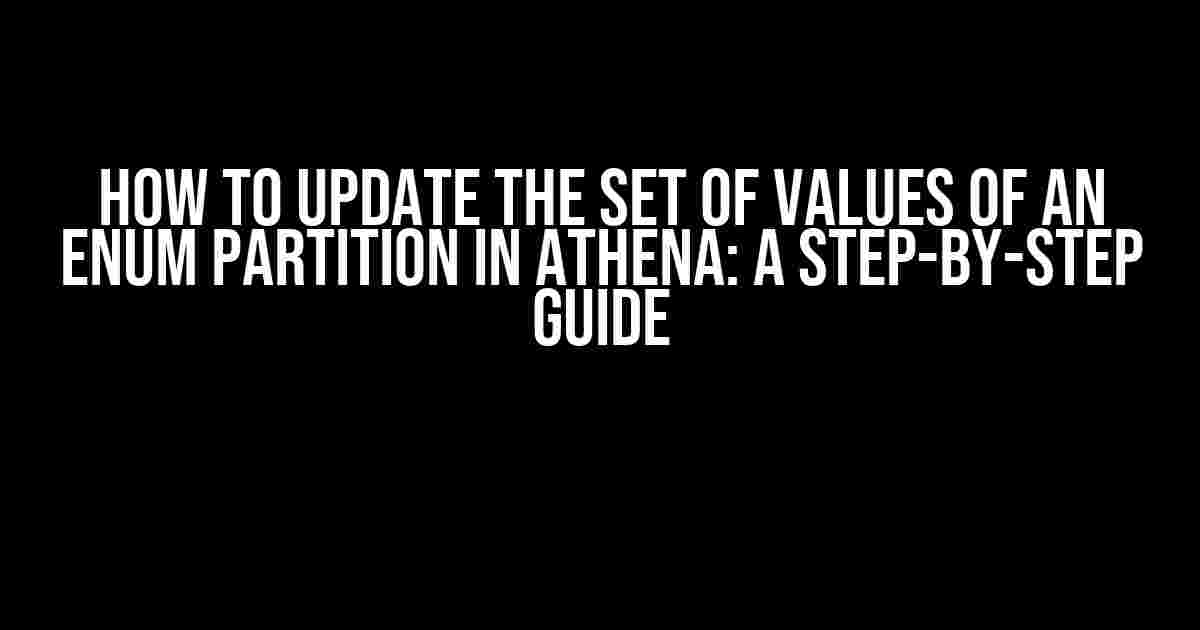Athena, Amazon’s powerful data analytics service, allows you to store and query large datasets using SQL. One of the most useful features of Athena is its support for enum partitions, which enable you to categorize and query data based on specific values. But, what happens when you need to update the set of values of an enum partition? Fear not, dear reader, for this article will walk you through the process with crystal-clear instructions and explanations!
Why Update Enum Partitions in Athena?
Before we dive into the how, let’s talk about the why. Updating the set of values of an enum partition in Athena can be crucial in various scenarios:
- Business requirements change: Perhaps your organization has introduced new product categories, and you need to reflect these changes in your enum partition.
- Data quality improvement: You’ve identified incorrect or outdated values in your enum partition and need to update them to ensure data accuracy.
- New data sources: You’ve added new data sources that require updating the enum partition to accommodate new values.
Understanding Enum Partitions in Athena
Before updating the set of values, it’s essential to understand how enum partitions work in Athena. Enum partitions are a type of partitioning scheme that allows you to divide your data into distinct categories based on specific values. In Athena, enum partitions are defined using the `ENUM` data type, which enables you to specify a list of allowed values for a particular column.
CREATE TABLE my_table (
id INT,
category ENUM('category_a', 'category_b', 'category_c')
) PARTITION BY (category);
In this example, the `category` column is an enum partition with three allowed values: `category_a`, `category_b`, and `category_c`. When you query the table, Athena uses the enum partition to optimize performance and storage.
Updating the Set of Values of an Enum Partition in Athena
Now that you understand enum partitions, let’s get to the meat of the matter: updating the set of values. There are two approaches to update an enum partition in Athena:
Method 1: Altering the Table Schema
The first method involves altering the table schema to update the enum partition. This approach requires caution, as it can impact existing data and queries.
ALTER TABLE my_table ALTER PARTITION (category) RENAME TO (category_new);
ALTER TABLE my_table ALTER PARTITION (category_new) TYPE ENUM('category_a', 'category_b', 'category_c', 'new_category_d');
In this example, we rename the existing enum partition to `category_new` and then update the enum partition to include a new value, `new_category_d`. Note that this approach can be time-consuming and may require re-partitioning your data.
Method 2: Creating a New Table with the Updated Enum Partition
The second method involves creating a new table with the updated enum partition and then swapping it with the original table. This approach is more convenient and less risky than altering the table schema.
CREATE TABLE my_table_new (
id INT,
category ENUM('category_a', 'category_b', 'category_c', 'new_category_d')
) PARTITION BY (category);
INSERT INTO my_table_new SELECT * FROM my_table;
DROP TABLE my_table;
ALTER TABLE my_table_new RENAME TO my_table;
In this example, we create a new table, `my_table_new`, with the updated enum partition. We then insert all data from the original table into the new table and drop the original table. Finally, we rename the new table to the original table name.
Troubleshooting and Best Practices
When updating the set of values of an enum partition in Athena, keep the following in mind:
- Backup your data: Before making any changes, ensure you have a backup of your data to avoid potential losses.
- Test and validate: Thoroughly test and validate your changes to ensure they don’t impact existing queries or data integrity.
- Use version control: Use version control systems to track changes to your table schema and enum partitions.
- Avoid altering live tables: Try to avoid altering live tables, as it can cause performance issues and data inconsistencies. Instead, create a new table with the updated enum partition and swap it with the original table.
Conclusion
Updating the set of values of an enum partition in Athena might seem daunting, but with the right approach and understanding of enum partitions, it’s a straightforward process. Remember to choose the method that best suits your needs, and always prioritize data safety and integrity. By following this guide, you’ll be well on your way to updating your enum partitions with confidence!
| Method | Description | Risk Level |
|---|---|---|
| Altering Table Schema | Update enum partition by altering table schema | High |
| Creating New Table | Create new table with updated enum partition and swap with original table | Low |
By now, you should have a clear understanding of how to update the set of values of an enum partition in Athena. Remember to bookmark this article for future reference, and happy querying!
Frequently Asked Question
Get ready to update your enum partition in Athena like a pro!
How do I update the set of values of an enum partition in Athena?
You can update the set of values of an enum partition in Athena by using the `ALTER TABLE` statement. Specifically, you’ll need to use the `ALTER COLUMN` clause to modify the enum column, and then specify the new set of values using the `VALUES` keyword. For example: `ALTER TABLE my_table ALTER COLUMN my_enum_column TYPE my_enum_type VALUES (‘new_value1’, ‘new_value2’, …);`
Can I add new values to an existing enum partition in Athena?
Yes, you can add new values to an existing enum partition in Athena. When you update the enum column using the `ALTER TABLE` statement, you can specify new values in addition to the existing ones. Athena will automatically update the partition to include the new values.
What happens if I try to update an enum partition with a value that already exists?
If you try to update an enum partition with a value that already exists, Athena will simply ignore the duplicate value and update the partition with the new values that don’t already exist. No errors will be thrown, and the update will be successful.
Can I remove values from an enum partition in Athena?
Unfortunately, you can’t remove values from an enum partition in Athena directly. However, you can create a new enum partition with the desired values and then update the table to use the new partition. Alternatively, you can use a workaround like creating a new column with the updated enum values and then dropping the original column.
Do I need to recreate my table or data pipeline after updating the enum partition?
No, you don’t need to recreate your table or data pipeline after updating the enum partition. The update is executed in-place, and Athena will automatically update the partition metadata. Your existing queries and data pipelines will continue to work as usual, and you can start querying the updated partition right away!


